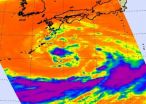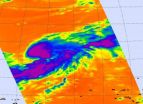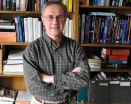(Press-News.org) Researchers have identified promising new therapies for ependymoma, a rare tumor with few treatment options. St. Jude Children's Research Hospital investigators led the effort, which used a new, faster drug development system that combines the latest drug screening technology with the first accurate animal model of the tumor.
Investigators identified several dozen new and existing drugs as possible ependymoma treatment candidates. The drugs were found by screening 5,303 existing medicines, natural products and other compounds for activity against the tumor, which develops in the brain and spine of children and adults. The work is published in the current edition of the scientific journal Cancer Cell.
The list of candidate drugs included 5-fluorouracil (5-FU). 5-FU has been widely used to treat a variety of adult cancers but has not been formally tested against ependymoma. Based on study results, St. Jude is planning a clinical trial of 5-FU in young ependymoma patients, said senior author Richard Gilbertson, M.D., Ph.D., director of the St. Jude Comprehensive Cancer Center. Gilbertson credited the method used in this study with highlighting 5-FU's potential.
Researchers hope to use the same system to expand chemotherapy options for patients with other cancers. "This approach should significantly advance the efficiency and speed with which we discover and develop new treatments for rare cancers and cancer subtypes," the investigators noted. Jennifer Atkinson, Ph.D., a former St. Jude postdoctoral fellow, is the first author. R. Kiplin Guy, Ph.D., chair of the St. Jude Department of Chemical Biology and Therapeutics, and Gilbertson are corresponding authors.
Rather than waiting years for clinical trial results, this system promises to take just months to provide key information about a drug's effectiveness and optimal administration, Gilbertson said.
The results are good news for patients with ependymoma and other cancers where treatment options are limited and the outlook remains bleak. While overall childhood cancer survival rates are now almost 80 percent, ependymoma remains incurable in up to 40 percent of patients. The tumor is found in 150 to 200 U.S. children annually, making it the third most common pediatric brain tumor. Treatment has changed little in the past 40 years and is limited to surgery and radiation.
Along with identifying and prioritizing drug development candidates against ependymoma, the research provided insight into the tumor's biology. The screening identified several messenger proteins, known as kinases, as possible new regulators of the tumor cell proliferation that makes cancer deadly. The abnormal tumor kinase activity occurred in certain pathways in tumor cells, including the insulin-signaling pathway and the centrosome cycle.
This study builds on earlier research led by Gilbertson that showed ependymoma includes nine different tumor subtypes. Each begins when particular mutations occur in stem cells from different regions of the brain or spine. Stem cells are the specialized cells that can divide and take on more specific functions.
For this project, investigators focused on a subtype D ependymoma. In earlier research, Gilbertson and his colleagues showed that extra copies of the EPHB2 gene caused this tumor subtype. The investigators used this information to develop an accurate model of subtype D ependymomas in mice. The mouse model includes the same mutation in the same neural stem cell responsible for the human disease and was crucial for speeding drug development.
Researchers used an automated system to check 5,303 existing drugs, natural products and other compounds for activity against four different types of mouse brain cells, including normal neural stem cells, subtype D ependymoma tumor cells and cells from a different brain tumor.
Of the 634 compounds that showed activity against subtype D ependymoma cells, four demonstrated a two-fold greater ability to block the growth of the tumor cells, but not normal cells. The drugs included 5-FU and two closely related compounds. The fourth was beta-escin, which belongs to a family of drugs that are generating interest as potential chemotherapy agents.
5-FU also proved more effective than four other chemotherapy drugs in slowing tumor growth and extending the lives of mice with subtype D ependymoma. 5-FU also appeared less toxic to normal mouse brain cells than another drug, bortezomib, included in the study. The findings provided preliminary evidence that the screening system might provide an early indication of drug toxicity. The information could help guide treatment and prioritize drugs for development, researchers said.
The screening also highlighted a possible role for kinase inhibitors. Those are drugs that block activity of proteins that help drive cell division and sustain tumors. More than 18 inhibitors are in clinical trials that target the kinases this study tied to proliferation of both normal and ependymoma tumor cells.
INFORMATION:
The study's other authors are Anang Shelat, Tanya Kranenburg, Nidal Boulos, Karen Wright, Helen Poppleton, Kumarasamypet Mohankumar, Timothy Phoenix, Paul Gibson, Liqin Zhu, Yiai Tong, Chris Eden, David Ellison, Amar Gajjar and Clinton Stewart, all of St. Jude; Angel Montero Carcaboso, Alexander Arnold, Robert Johnson Clementine Feau, all formerly of St. Jude; and Waldemar Priebe, Dimpy Koul and W.K. Alfred Yung, of University of Texas MD Anderson Cancer Center.
The study was funded in part by the National Institutes of Health, the Collaborative Ependymoma Research Network and ALSAC.
St. Jude Children's Research Hospital
St. Jude Children's Research Hospital is internationally recognized for its pioneering research and treatment of children with cancer and other life-threatening diseases. The hospital's research has helped push overall survival rates for childhood cancer from less than 20 percent when the institution opened to almost 80 percent today. It is the first and only National Cancer Institute-designated Comprehensive Cancer Center devoted solely to children, and no family ever pays St. Jude for care. For more information, visit www.stjude.org.
END
To highlight Pain Awareness Month in September, The Gerontological Society of America (GSA) — the nation's largest interdisciplinary organization devoted to the field of aging — is announcing two forthcoming publications focused on pain relief and medication for seniors.
Paired with its other recent research findings, GSA aims to provide readers with information on how new advances in pain prevention, treatment, and management may improve care and quality of life for older adults.
Both new publications are part of GSA's From Publication to Practice series, which aims ...
PHILADELPHIA - The changing tide of Alzheimer's diagnosis presents new challenges to the public, physicians and lawmakers: if you could find out your Alzheimer's risk, would you want to know? How should doctors tell you your risk? And what does it mean for the many newly diagnosed Americans still in the workplace?
Despite the emergence of new tools that can diagnose Alzheimer's earlier, no effective interventions have been identified to stop the progression of the disease. A new report from the Perelman School of Medicine at the University of Pennsylvania tackles the ...
NASA's TRMM satellite peers through clouds and can decipher the rate rain is falling within a tropical cyclone, and data from the satellite shows that the heaviest rainfall is occurring in the northwestern quadrant of the storm, away from Bermuda.
The Tropical Rainfall Measuring Mission (TRMM) satellite traveled above tropical storm Maria on Thursday, September 15, 2011 at 1001 UTC ( 6:01 a.m. EDT). TRMM has the ability to measure rainfall rates and cloud heights, two factors that are important and helpful to the National Hurricane Center (NHC) meteorologists who are ...
A new model of obsessive-compulsive disorder (OCD) that mirrors both symptoms of the disease and the timing of its treatment in humans has been created by University of Chicago researchers, according to a new study.
Using the model, researchers isolated a single neurotransmitter receptor in a specific brain region responsible for their model's OCD-like symptoms, offering new insight into the cause of the disorder. Further research with the model may point the way to new treatments for both OCD and autism, said Nancy Shanahan, PhD, lead author of the paper in Biological ...
Tropical Storm Roke is showing some signs of intensification on NASA infrared satellite imagery, as areas of strong convection and very cold cloud tops were spotted. Kadena Air Base in Okinawa is now in Roke's sights and should be making preparations.
NASA's Aqua satellite flew over Roke yesterday and the Atmospheric Infrared Sounder (AIRS) instrument showed powerful convection building around the storm's center and over the northern edge. Meanwhile, dry air is wrapping into the low-level center from the southwest, and limiting cloud development.
Infrared imagery provides ...
Infrared satellite imagery from NASA's Aqua satellite yesterday showed powerful convection building in the low pressure area known as System 94W and provided forecasters with an inside look that the low was strengthening. System 94W did intensify and became Tropical Storm Sonca today.
Infrared imagery is gathered by the Atmospheric Infrared Sounder (AIRS) instrument that flies on NASA's Aqua satellite. It provides valuable information to forecast organizations such as the Joint Typhoon Warning Center and National Hurricane Center about cloud temperatures and heights and ...
Cake Decorating Teacher's blog is dedicated to serving online viewers with a listing of easy to make recipes. Weekly blog posts include delicious dessert recipes at www.cakedecoratingteacher.com along with how to instructions for their readers convenience.
Life has never been this easy when it comes to finding free access to great baking recipes since the Internet and its listing of blog sites such as Cake Decorating Teacher. Posts can easily be viewed under the posts section of their website. To stay updated on the latest posts readers can subscribe to the blog's RSS ...
AMES, Iowa – Even though a dwarf galaxy clear across the Milky Way looks to be a mouse, it may have once been a bear that slashed through the Milky Way and created the galaxy's spiral arms, writes an Iowa State University astronomer in the journal Nature.
Curtis Struck, an Iowa State professor of physics and astronomy, uses a News & Views commentary in the Sept. 15 issue of Nature to add context and color to a study published in the same issue by a research team led by Chris W. Purcell of the University of Pittsburgh.
The Purcell group reports that the Sagittarius Dwarf ...
After nearly two years of committed planning and design, the 2011 Solar Decathlon Team Massachusetts heads to Washington, D.C. where its completed "4D Home" will participate alongside 19 other collegiate entries in this year's competition. A unique dwelling that boasts both affordable and sustainable design elements, the "4D Home" is fully solar-powered, cost-effective and energy-efficient.
"Team Massachusetts showcases public higher education at its best. The creation of this self-sustaining home designed and developed by students at Massachusetts ...
From the very beginning our philosophers and scientists realized that the key to great societies was wisdom. They saw that wisdom was real and that if only they could figure out what it is and how to teach it; they would be able to create wise societies. Ever since the times of Aristotle till today, man has been trying to figure out wisdom by putting wisdom under the microscope. As wisdom is an innate property of the pure self it is a secondary entity; just like fragrance is a property of the flower. It is exactly like a symptom of a disease. So by putting wisdom under ...



